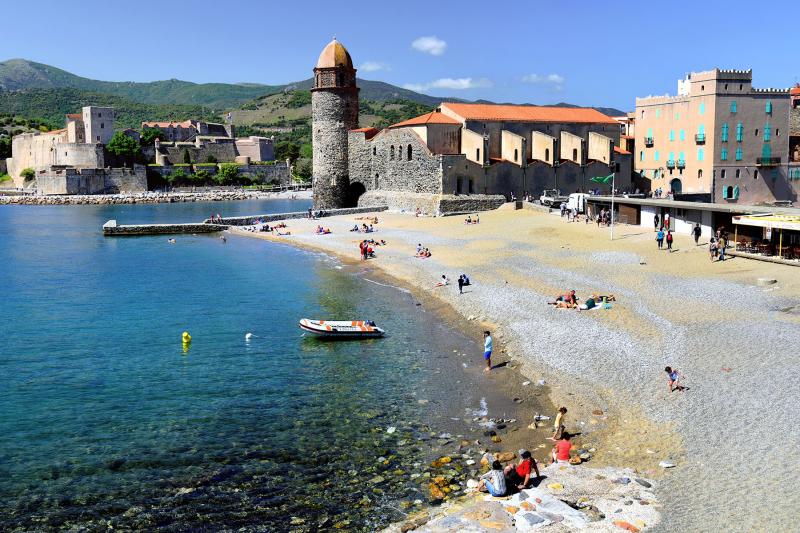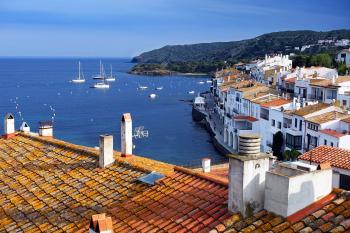Seaside sisters: Tranquil towns snuggle on the Franco-Spanish border
Appears in the Online Edition, May 2019.
Along the western Mediterranean coast, two easygoing -- and easy-to-enjoy -- beach towns stand like sister cities on each side of the border between France and Spain. Both Collioure, in France, and Cadaques, in Spain, are off the grid when it comes to glitzy resorts. And each has a delightful ambience, with welcoming beaches, quaint back streets, and scenery that inspired many notable 20th-century artists.
On the French side, Collioure is where I like to unwind and regroup. When I'm here, I enjoy a slow coffee on la Med, lose myself in the old town's streets, compare the gelato shops on Rue Vauban, relax on a pebble-sand beach, and take a hike. The hills above Collioure deliver fantastic views of its bay and the sun-bleached, terracotta-roofed village below. Most of Collioure's shopping, sights and hotels cluster in the old town -- most romantic in the evening, when yellow lamps reflect warm pastels and deep blues. By Mediterranean standards, this seaside village should be slammed with tourists; it has everything. But, outside of peak times, it is remarkably quiet.
Collioure is blessed with a privileged climate and an enviable setting. For more than 2,500 years, empires have battled to control its position on the Mediterranean at the foot of the Pyrenees. The mountains rising behind Collioure provided a natural defense, and its sheltered port gave it a commercial edge. Today, it's a pastel treat with six petite and pebbly beaches, leafy squares under a once-mighty castle, and a lighthouse to mark where the Pyrenees meet the sea. It's no wonder that artists such as Henri Matisse, Andre Derain, Pablo Picasso, Georges Braque, Raoul Dufy, and Marc Chagall all painted here at one time or another.
Just 15 miles from the border, Collioure shares a common history and independent attitude with its rebellious siblings across the border in the Spanish province of Catalonia. Undeniably French yet with a proud strain of Catalan culture, it flies the yellow and red flag of Catalonia, displays street names in French and Catalan, and sports a few business names with el and els, rather than le and les. Less than a century ago, most locals here spoke Catalan; today that language is enjoying a resurgence as Collioure rediscovers its roots.
About an hour-and-a-half drive away, Cadaques is a seaside gem at the easternmost tip of Spain. With whitewashed buildings, a gentle ocean breeze and dreamy bay views, Cadaques is idyllic and remote. It has no train service and only a tiny access road that dead-ends. If you want a peaceful beach escape near Barcelona, this is it.
Since the late 1800s, Cadaques has served as a haven for intellectuals and artists. The fishing village's craggy coastline, sun-drenched colors, and laid-back lifestyle inspired Fauvists such as Matisse and Surrealists like Rene Magritte, Marcel Duchamp, and Federico Garcia Lorca. Even Picasso painted some of his Cubist works here.
Most travelers in Cadaques are here to see the home of Surrealist artist Salvador Dali. I consider it the most interesting home of a deceased personality in all of Europe. (It's very popular and only allows eight visitors at a time for escorted tours, so you must get reservations online in advance.) Dali was raised in nearby Figueres and brought international fame to this sleepy Catalan port in the 1920s. As a kid, Dali spent summers here in the family cabin, where he was fascinated by the rocky landscape that would later be the backdrop for many Surrealist canvases. He and his wife (and muse) Gala converted a fisherman's home -- about a 20-minute walk from the city center -- into their semipermanent residence, dividing their time between New York, Paris and Cadaques. It was here that Dali did his best work.
Beyond the Dali House, Cadaques offers little in the way of sights, but the old town is remarkably characteristic. I like to stroll along the water from the Dali statue on the beach, past the casino where time stands still, and admire the "elephant trees" imported from Cuba (many Catalans moved to Cuba in the 19th century and came back home when Spanish rule ended). Uphill, the Jewish Quarter is still rich with vestiges of the strong Jewish community that thrived in Spain until 1492. That's when Christian fanaticism (gone wild with the final victory over the Moors) led to the expulsion of Jews and Muslims from Catholic Spain. At the top of town, the Church of Santa Maria offers commanding views of Cadaques. Inside, an opulent Baroque altar features 365 carved figures covered in gold from the Americas.
In spite of its fame, Cadaques is mellow and feels off the beaten path, much like its French counterpart, Collioure. In these two sister towns, time seems to move a little slower, and that's exactly what makes them so enjoyable.
(Rick Steves (www.ricksteves.com) writes European travel guidebooks and hosts travel shows on public television and public radio. Email him at rick@ricksteves.com and follow his blog on Facebook.)


